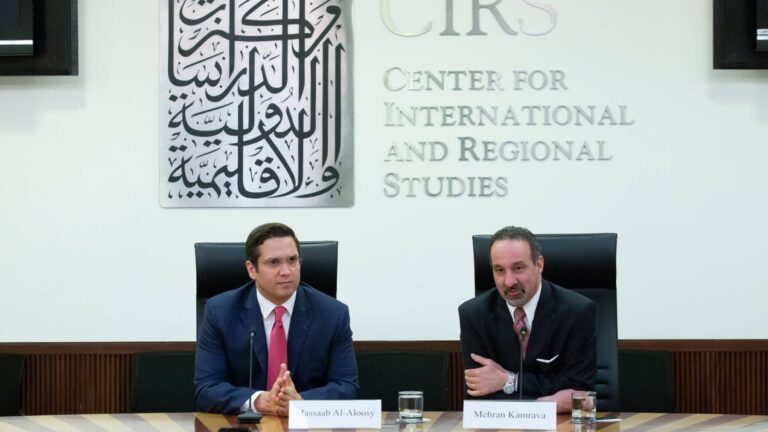Distingushed Lectures, Regional Studies
Fundamentalist Metamorphosis: Hezbollah’s Ideological Evolution from Idealism to Pragmatism

On January 16, 2019, CIRS invited Middle East analyst Massaab Al-Aloosy to discuss his research on “Fundamentalist Metamorphosis: Hezbollah’s Ideological Evolution from Idealism to Pragmatism.” During the talk, he mapped out the trajectory of Hezbollah (“Party of God”), a political and militant Shiʿa Islamist movement, from its origin to the present. The organization came into existence following the Israeli invasion of Lebanon in 1982, and was primarily concerned with ending Israel’s occupation in Lebanon and supporting the Palestinian cause.
Before it was officially organized in 1985, Hezbollah worked as a clandestine operation inspired by several geopolitical events, including the Iranian Revolution and the overthrow of the shah in 1979, and Ayatollah Khomeini’s revolutionized Shiʿa theology, which was exported to Shi’a communities, including those in Lebanon. Aloosy said that Khomeini “gave a directive for the clergy in ruling the country and being involved in politics. This had great ramifications in the region as a whole, but specifically for the Shiʿa and the Arab world.”
Another event inspiring Hezbollah’s actions was Israel’s invasion of Lebanon in 1982 in its attempt to uproot the Palestinian Liberation Organization from southern Lebanon. According to Al-Aloosy, “This was a massive shock for the Lebanese and the Arab world, to see an Arab capital invaded by Israelis forces.” This event profoundly affected the Shiʿa in the Lebanon because of their constant friction with Israel, leading Hezbollah to launch military operations against Israeli targets, including an Israeli encampment—one of their most devastating attacks against the Israeli Defense Forces (IDS).
Hezbollah “reflected much of Iran’s revolutionary rhetoric; the oppressed versus the oppressors; siding with the people; creating revolutions throughout the region.”
Hezbollah sent an open letter to the world in 1985, declaring its goals. “It reflected much of Iran’s revolutionary rhetoric; the oppressed versus the oppressors; siding with the people; creating revolutions throughout the region,” Al-Aloosy said. One goal was to create an Islamic state, which proved extremely ambitious because Lebanon is a “multi-confessional, multi-religious, multi-ethnic, multi-sectarian country.” Another goal was to destroy Israel; Hezbollah “considered Israel as a cancerous gland, which should be completely destroyed; and they would not stop until they liberated every inch of Palestine,” he said.
In 1989, Saudi Arabia gathered many Lebanese politicians together and paid them handsomely to sign an agreement to end the Lebanese civil war and amend the divided political system, he said. Hezbollah was initially against the Taif Agreement, but later decided it was necessary to engage in Lebanese politics. Taking this pragmatic step, Al-Aloosy said, Hezbollah “had a revolutionary outlook that had completely changed with accepting the political system.”
During the 1990s, Hezbollah underwent a process of “refashioning Islamism,” Al-Aloosy said. In the 1980s, their positions had been quite extremist, but over time, “they changed all of this rhetoric, and they tried to change the interpretation of what they said.” Hezbollah’s focus was on Israel, and their perspective had become more nationalistic than Islamist. For example, Al-Alsoosy said that the rhetoric became: “We are here to liberate Lebanese land, mainly. This is our objective.”
The quest for an Islamic state remained, however, but it was “indefinitely postponed,” Al-Aloosy noted. Additionally, Hezbollah acknowledged that the goal of an Islamic state did not mean that it will be imposed by force, and it had to come with the consensus of all Lebanese. “You can imagine how impossible that would be,” Al-Aloosy said, “not even the Shiʿites themselves agree on an Islamic state.” Reaching a consensus among Lebanon’s many communities—including Sunnis, Christians, and Druze, among others—was considered an almost impossible feat, he said.
Further, in 1999, Ehud Barak was elected Prime Minister of Israel on a platform of withdrawing Israeli forces from Lebanon, which occurred in 2000. Despite this, Hezbollah continued its attacks on Israel from 2000 to 2006, but these were not as intense as those of the 1990s. In 2006, “a big miscalculation by both Hezbollah and Israel happened,” he explained. Now under the premiership of Ehud Olmert, Israel decided it would destroy Hezbollah. In 2006, a war erupted between Israel and Hezbollah, lasting for over a month. Hezbollah was not destroyed in this conflict, but, since then, the border between Israel and Lebanon has been comparatively quiet.
Syria, throughout the 1990s, had been using Hezbollahs’ attacks to pressure the Israelis to the negotiating table, Al-Aloosy said, but Israel’s withdrawal from southern Lebanon deprived Syria of a very important negotiating tool with the Israelis. With the civil uprising in Syria in 2011, “this was yet another event that served to make Hezbollah’s ideology more pragmatic and less idealistic,” Al-Aloosy said. Instead of siding with the oppressed, Hezbollah chose to side with Syrian President Bashar al-Assad.
In conclusion, Al-Aloosy argued that Hezbollah has transformed from an offensive force against the Israelis to liberate the south of Lebanon, into a deterrent force. Hezbollah continues the rhetoric of liberating Palestine, he said, but does not actually do much about it. Hence, “when it comes to creating an Islamic state, it is very clear this goal is unattainable especially in the sectarian mosaic of Lebanon. Thus, they engaged in changing the rhetoric and changed their outlook indirectly.”
Article by Khansa Maria, CURA Publications Fellow
Massaab Al-Aloosy received his PhD and Masters of Art in Law and Diplomacy from the Fletcher School of Law and Diplomacy at Tufts University. Previously, he worked with the World Peace Foundation and is currently working as a producer with the Al Jazeera Network. He is the author of a forthcoming book, titled Changing Ideology of the Hezbollah Insurgency and Civil War in the Middle East.